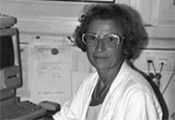Carmen Berthet, former staff scientist, passed away on 13 September 2001, aged 61.
Carmen Berthet, staff scientist at the EMBL Grenoble Outstation, died on 13 September 2001 only a few weeks after being diagnosed with pancreatic cancer. During that historic week we had to grapple with our own local tragedy as well as the global one (9/11). It was a very difficult time for everyone.
Carmen originated from Barcelona where she was trained as a physicist. She moved to Grenoble in 1962 to pursue her PhD work in neutron diffraction from magnetic materials and from 1969-1975 was a scientist at the Institute Laue-Langevin responsible for the diffractometer D2. Carmen was one of the founder recruits to the EMBL Grenoble Outstation which was established in late 1975, along with Dino Tochetti, Jo Sedita and Jean-Marie Bois. Under the first Head of Outstation, Dr. Andrew Miller she installed the first X-ray generator (and remained responsible for the Outstation X-ray facilities ever since) and pursued research on X-ray and neutron diffraction studies of collagenous materials. That was the time of rat-tail tendons, turkey tendons, fish bones and bovine inter-vertebral disc, but publications in Science and Nature nevertheless! With the coming in 1980 of the second Head of Outstation, Bernard Jacrot, the focus of the laboratory and Carmen’s work switched to virus structure, firstly by neutron and X-ray (including time-resolved) small angle scattering, and eventually by X-ray crystallography. Indeed crystals of the adenovirus fibre grown in the laboratory by Christiane Devaux were a stimulus to both Carmen and me to learn the technique of protein crystallography in the mid-1980s.
However we struggled in vain with the these crystals as the techniques available for handling thin, often twined plate-like crystals of a fibrous protein with a 580Å unit cell were at that time inadequate. It was not until ten years later that the adenovirus fibre structure was solved. We had more luck with aminoacyl-tRNA synthetases, a subject introduced into the laboratory by Reuben Leberman and Michael Härtlein. Nicolas Nassar, a PhD student, Carmen and I eventually solved the structure of seryl-tRNA synthetase, the first of the novel class II of synthetases. That was still the heroic period of protein crystallography, of week long measuring sessions at LURE or EMBL Hamburg, breathing dark room fumes to develop the stacks of films. In the 1990s, by which time we had our own synchrotron next door and more user friendly detectors had been developed, Carmen worked closely with students on two other difficult crystallographic projects. The first, the structure of the E.coli EfTu-EfTs complex, was the PhD project of Taki Kawashima and was published in Nature as the first structure of a G-protein/exchange factor complex. The trick here was to control the dehydration induced shrinking of the crystals to get the higher diffracting form. The second project, the structure of p24, the HIV capsid protein, in complex with an Fab, was a collaboration with a pharmaceutical company, bioMerieux and initiated via a contact of Carmen’s who had been a stagaire previously in the laboratory. Carmen crystallised the p24-Fab complex and worked with PhD student Stephanie Monaco to solve the structure. The crystals were very thin and almost always twinned (compare the adenovirus fibre above!) but this time we had sophisticated microfocus technology at the ESRF to help out. This structure remains the only one of the complete p24 molecule whose two flexibly linked domains were otherwise solved separately.
The most recent projects Carmen had been working on were related to asparaginyl-tRNA synthetase. She solved the first structure of this enzyme together with one of Reuben Leberman’s PhD students, Lawrence Seignovert. In the last two years this project was extended to the asparginyl-tRNA synthetase from the human parasitic nematode Brugia malayi. This worm is the causative agent of filariasis, at widespread and debilitating tropical disease. This work, in collaboration with Michael Härtlein and Michael Kron (Michigan State University), is supported by the World Health Organisation which is promoting the search for potential targets and drugs to kill adult worms (macrofilaricide). Carmen crystallised and solved the structure of this enzyme and spent her last months trying to soak into crystals or co-crystallise lead compounds which were identified to inhibit the enzyme in a limited high throughput screen. Unfortunately she was not successful in this enterprise before she died.
Over the 25 years of Carmen’s career at EMBL, the Outstation has changed enormously, growing both in size and scientific reputation, to which Carmen’s solid scientific output contributed significantly. But, during this time, one constant has been Carmen’s enthusiasm, generosity and energy which have never failed to help maintain the laboratory as more than just a place of work but a warm and friendly community. Many staff members, students, visitors and external scientific colleagues have interacted with her over that period and we have received messages of condolence from a large number of them, including some that lost touch many years ago. All remember her strength of character, good humour and understanding that often helped them in difficult moments. She was a mother to us all particularly for young scientists, notably women, and I think of Nicolas, Hassan, Taki, Stephanie and Lawrence, amongst many others who made their first steps in research accompanied by Carmen.
Before she died, Carmen often spoke of her two families, both of which were a central part of her life, the family at the laboratory and of course her own family, particularly her children and grand children.
Carmen never really left her native Barcelona and returned there to be laid to rest. She brought us the warmth and sun of Spain as summed up by a former PhD student, Nicolas Nassar: ‘I worked with Carmen during my thesis years at the EMBL. She was a happy, loving woman always ready to help. Just listening to her talking with her Catalan accent was enough to cheer you up’.
by Stephen Cusack
